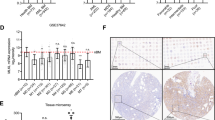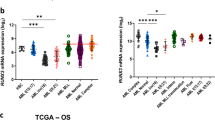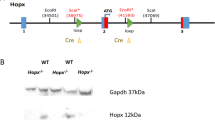Abstract
Embryonic development of multilineage hematopoiesis requires the precisely regulated expression of lineage-specific transcription factors, including AML-1 (encoded by Runx1; also known as CBFA-2 or PEBP-2αB)1,2,3,4,5. In vitro studies and findings in human diseases, including leukemias6,7, myelodysplastic syndromes8 and familial platelet disorder with predisposition to acute myeloid leukemia (AML)9, suggest that AML-1 has a pivotal role in adult hematopoiesis. However, this role has not been fully uncovered in vivo because of the embryonic lethality of Runx1 knockout in mice. Here we assess the requirement of AML-1/Runx1 in adult hematopoiesis using an inducible gene-targeting method10. In the absence of AML-1, hematopoietic progenitors were fully maintained with normal myeloid cell development. However, AML-1-deficient bone marrow showed inhibition of megakaryocytic maturation, increased hematopoietic progenitor cells and defective T- and B-lymphocyte development. AML-1 is thus required for maturation of megakaryocytes and differentiation of T and B cells, but not for maintenance of hematopoietic stem cells (HSCs) in adult hematopoiesis.
This is a preview of subscription content, access via your institution
Access options
Subscribe to this journal
Receive 12 print issues and online access
$209.00 per year
only $17.42 per issue
Buy this article
- Purchase on Springer Link
- Instant access to full article PDF
Prices may be subject to local taxes which are calculated during checkout




Similar content being viewed by others
References
Okuda, T., van Deursen, J., Hiebert, S.W., Grosveld, G. & Downing, J.R. AML1, the target of multiple chromosomal translocations in human leukemia, is essential for normal fetal liver hematopoiesis. Cell 84, 321–330 (1996).
Wang, Q. et al. Disruption of the Cbfa2 gene causes necrosis and hemorrhaging in the central nervous system and blocks definitive hematopoiesis. Proc. Natl. Acad. Sci. USA 93, 3444–3449 (1996).
Mukouyama, Y. et al. The AML1 transcription factor functions to develop and maintain hematogenic precursor cells in the embryonic aorta-gonad-mesonephros region. Dev. Biol. 220, 27–36 (2000).
Yokomizo, T. et al. Requirement of Runx1/AML1/PEBP2αB for the generation of haematopoietic cells from endothelial cells. Genes Cells 6, 13–23 (2001).
North, T.E. et al. Runx1 expression marks long-term repopulating hematopoietic stem cells in the midgestation mouse embryo. Immunity 16, 661–672 (2002).
Tenen, D.G., Hromas, R., Licht, J.D. & Zhang, D.E. Transcription factors, normal myeloid development, and leukemia. Blood 90, 489–519 (1997).
Lutterbach, B. & Hiebert, S.W. Role of the transcription factor AML-1 in acute leukemia and hematopoietic differentiation. Gene 245, 223–235 (2000).
Imai, Y. et al. Mutations of the AML1 gene in myelodysplastic syndrome and their functional implications in leukemogenesis. Blood 96, 3154–3160 (2000).
Song, W.J. et al. Haploinsufficiency of CBFA2 causes familial thrombocytopenia with propensity to develop acute myelogenous leukaemia. Nat. Genet. 23, 166–175 (1999).
Kuhn, R., Schwenk, F., Aguet, M. & Rajewsky, K. Inducible gene targeting in mice. Science 269, 1427–1429 (1995).
Jackson, C.W. Cholinesterase as a possible marker for early cells of the megakaryocytic series. Blood 42, 413–421 (1973).
Kaushansky, K. The enigmatic megakaryocyte gradually reveals its secrets. Bioessays 21, 353–360 (1999).
Elagib, K.E. et al. RUNX1 and GATA-1 coexpression and cooperation in megakaryocytic differentiation. Blood 101, 4333–4341 (2003).
Shivdasani, R.A., Fujiwara, Y., McDevitt, M.A. & Orkin, S.H. A lineage-selective knockout establishes the critical role of transcription factor GATA-1 in megakaryocyte growth and platelet development. EMBO J. 16, 3965–3973 (1997).
Takahashi, S. et al. Role of GATA-1 in proliferation and differentiation of definitive erythroid and megakaryocytic cells in vivo. Blood 92, 434–442 (1998).
Hodohara, K., Fujii, N., Yamamoto, N. & Kaushansky, K. Stromal cell-derived factor-1 (SDF-1) acts together with thrombopoietin to enhance the development of megakaryocytic progenitor cells (CFU-MK). Blood 95, 769–775 (2000).
Osawa, M., Hanada, K., Hamada, H. & Nakauchi, H. Long-term lymphohematopoietic reconstitution by a single CD34-low/negative hematopoietic stem cell. Science 273, 242–245 (1996).
Kondo, M., Weissman, I.L. & Akashi, K. Identification of clonogenic common lymphoid progenitors in mouse bone marrow. Cell 91, 661–672 (1997).
Rhoades, K.L. et al. Analysis of the role of AML1-ETO in leukemogenesis, using an inducible transgenic mouse model. Blood 96, 2108–2115 (2000).
Higuchi, M. et al. Expression of a conditional AML1-ETO oncogene bypasses embryonic lethality and establishes a murine model of human t(8;21) acute myeloid leukemia. Cancer Cell 1, 63–74 (2002).
de Guzman, C.G. et al. Hematopoietic stem cell expansion and distinct myeloid developmental abnormalities in a murine model of the AML1-ETO translocation. Mol. Cell. Biol. 22, 5506–5517 (2002).
Szilvassy, S.J., Humphries, R.K., Lansdorp, P.M., Eaves, A.C. & Eaves, C.J. Quantitative assay for totipotent reconstituting hematopoietic stem cells by a competitive repopulation strategy. Proc. Natl. Acad. Sci. USA 87, 8736–8740 (1990).
Lagasse, E. & Weissman, I.L. Flow cytometric identification of murine neutrophils and monocytes. J. Immunol. Methods 197, 139–150 (1996).
Taniuchi, I. et al. Differential requirements for Runx proteins in CD4 repression and epigenetic silencing during T lymphocyte development. Cell 111, 621–633 (2002).
Mikkola, H.K. et al. Haematopoietic stem cells retain long-term repopulating activity and multipotency in the absence of stem-cell leukaemia SCL/tal-1 gene. Nature 421, 547–551 (2003).
Yagi, T. et al. A novel ES cell line, TT2, with high germline-differentiating potency. Anal. Biochem. 214, 70–76 (1993).
Breton-Gorius, J., Reyes, F., Duhamel, G., Najman, A. & Gorin, N.C. Megakaryoblastic acute leukemia: identification by the ultrastructural demonstration of platelet peroxidase. Blood 51, 45–60 (1978).
Jackson, C.W., Brown, L.K., Somerville, B.C., Lyles, S.A. & Look, A.T. Two-color flow cytometric measurement of DNA distributions of rat megakaryocytes in unfixed, unfractionated marrow cell suspensions. Blood 63, 768–778 (1984).
Sherwood, S.W. & Schimke, R.T. Cell cycle analysis of apoptosis using flow cytometry. Methods Cell Biol. 46, 77–97 (1995).
Acknowledgements
We thank S. Aizawa for providing us with TT2 ES cells; T. Komori for Runx1 genomic fragments; J. Takeda for Mx-cre-transgenic mice; and thank K. Kumano, A. Kunisato and other members of H.H.'s lab for critical discussion. This work was supported in part by a Grant-in-Aid for Scientific Research (KAKENHI 13307029, 15689015) from the Japan Society for the Promotion of Science, and by Health and Labour Sciences Research grants from the Ministry of Health, Labour and Welfare.
Author information
Authors and Affiliations
Corresponding author
Ethics declarations
Competing interests
The authors declare no competing financial interests.
Rights and permissions
About this article
Cite this article
Ichikawa, M., Asai, T., Saito, T. et al. AML-1 is required for megakaryocytic maturation and lymphocytic differentiation, but not for maintenance of hematopoietic stem cells in adult hematopoiesis. Nat Med 10, 299–304 (2004). https://doi.org/10.1038/nm997
Received:
Accepted:
Published:
Issue Date:
DOI: https://doi.org/10.1038/nm997
This article is cited by
-
Runt-related transcription factors in human carcinogenesis: a friend or foe?
Journal of Cancer Research and Clinical Oncology (2023)
-
Myeloid neoplasms and clonal hematopoiesis from the RUNX1 perspective
Leukemia (2022)
-
Runx1 and Runx2 inhibit fibrotic conversion of cellular niches for hematopoietic stem cells
Nature Communications (2022)
-
HOXA9 has the hallmarks of a biological switch with implications in blood cancers
Nature Communications (2022)
-
The mutual regulatory loop between TPTEP1 and miR-1303 in leukemogenesis of acute myeloid leukemia
Cancer Cell International (2021)



